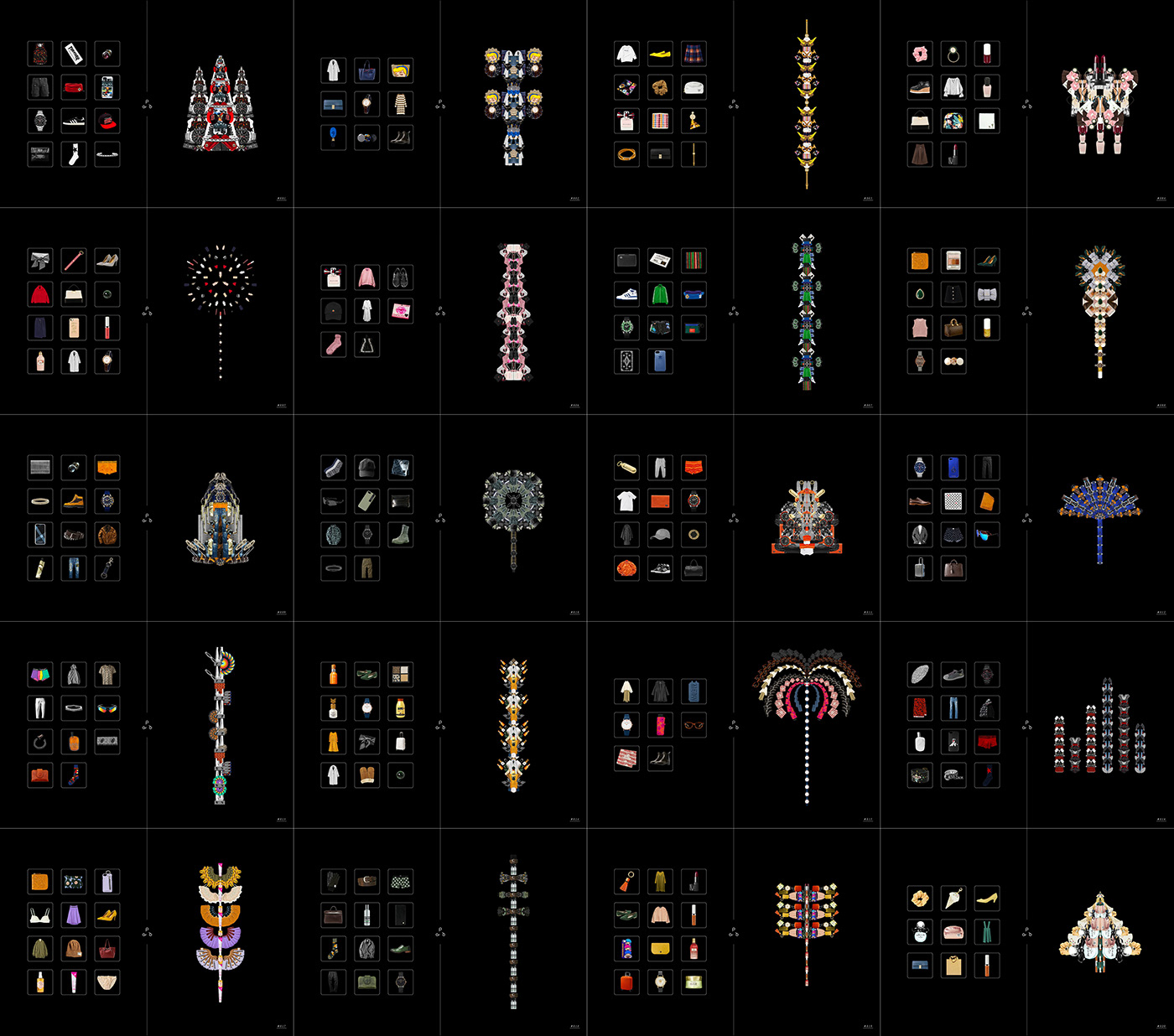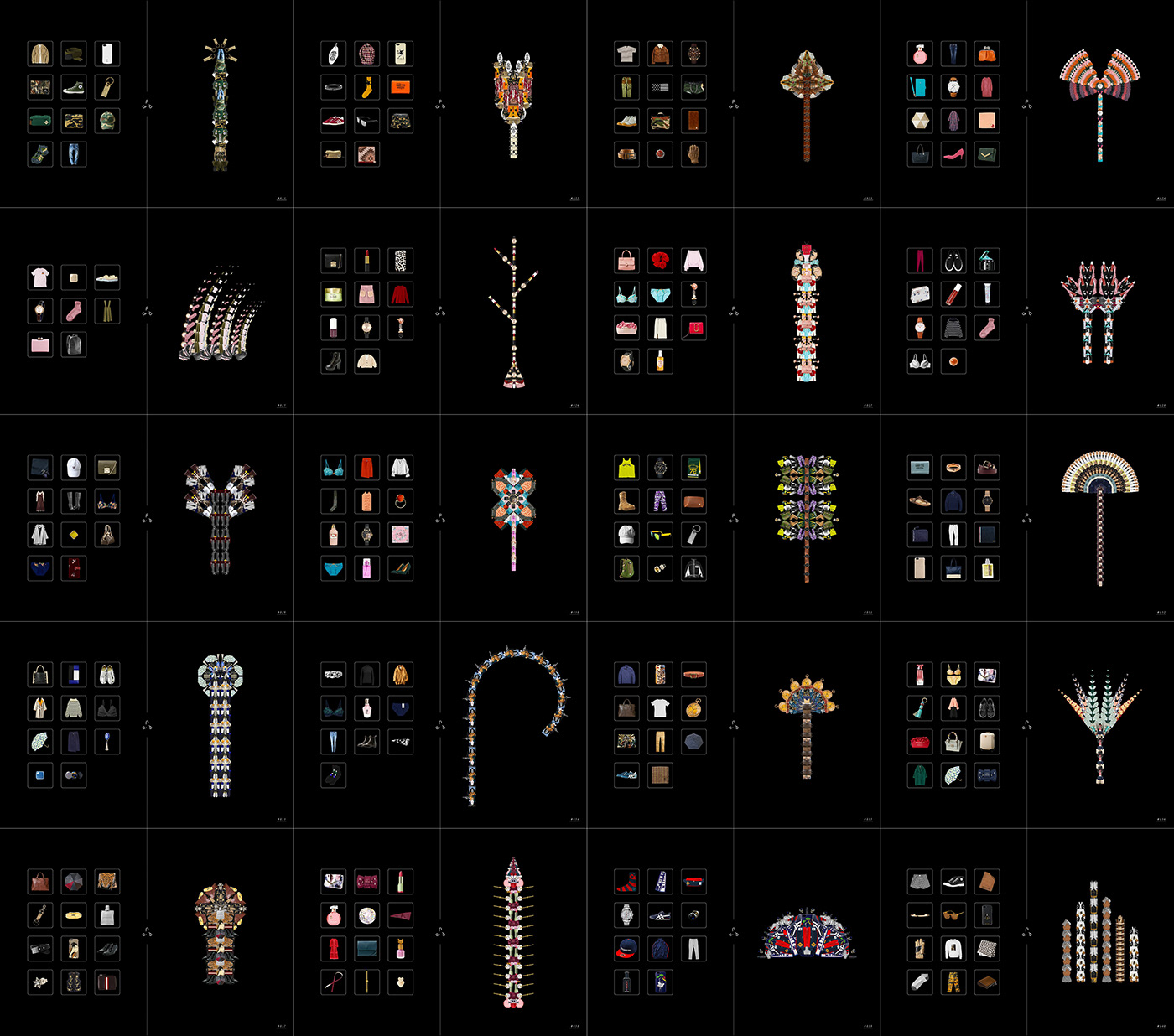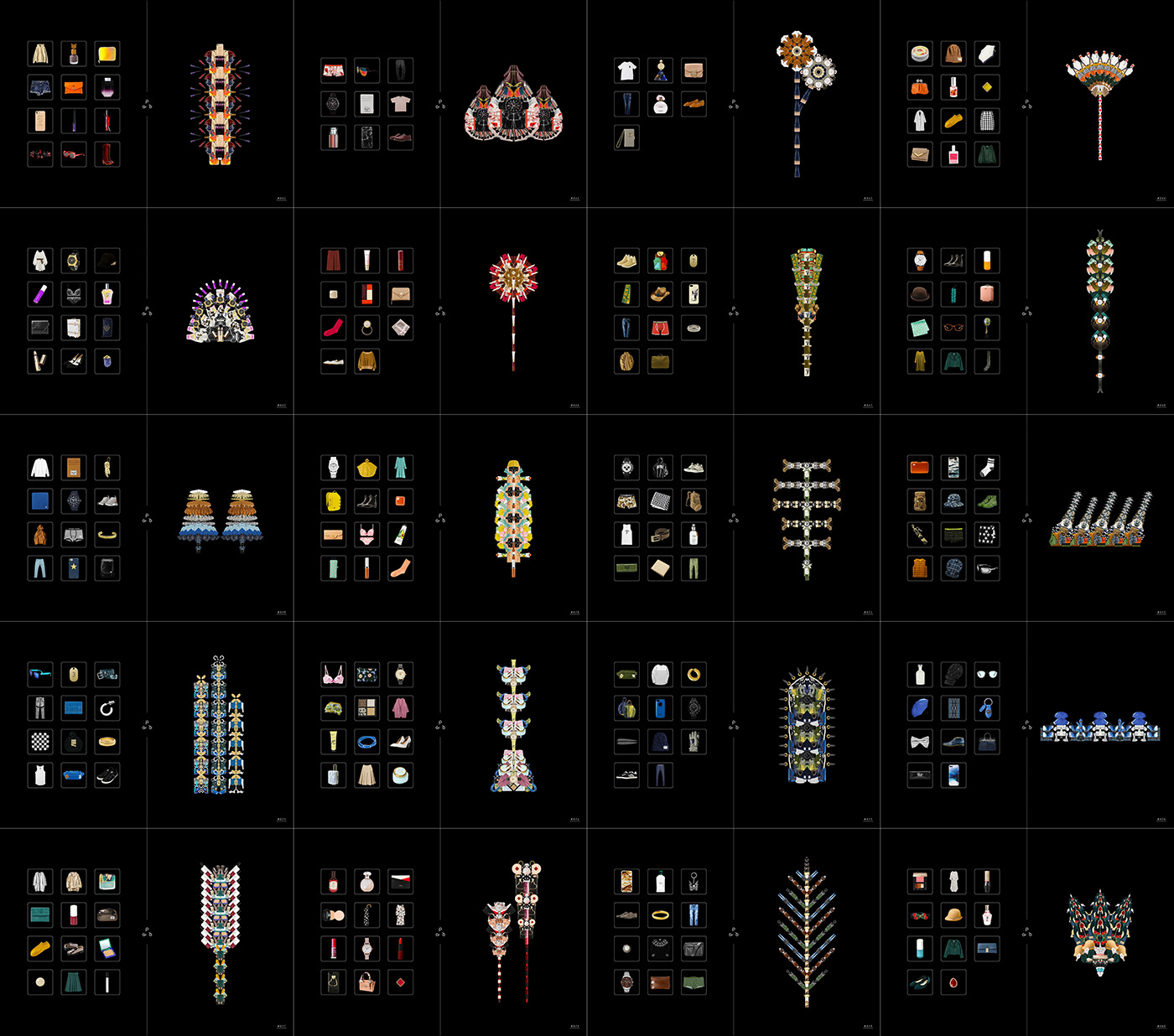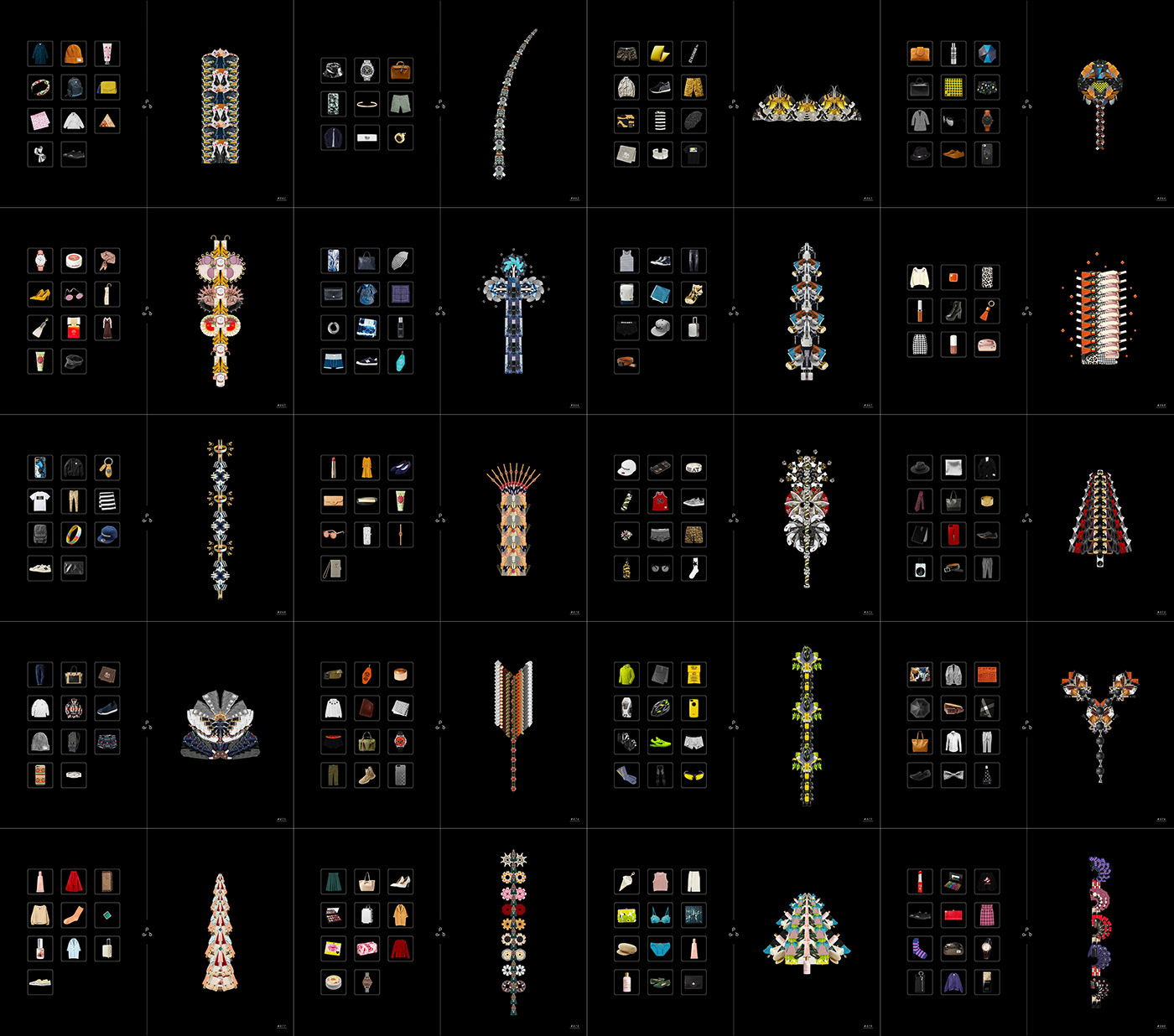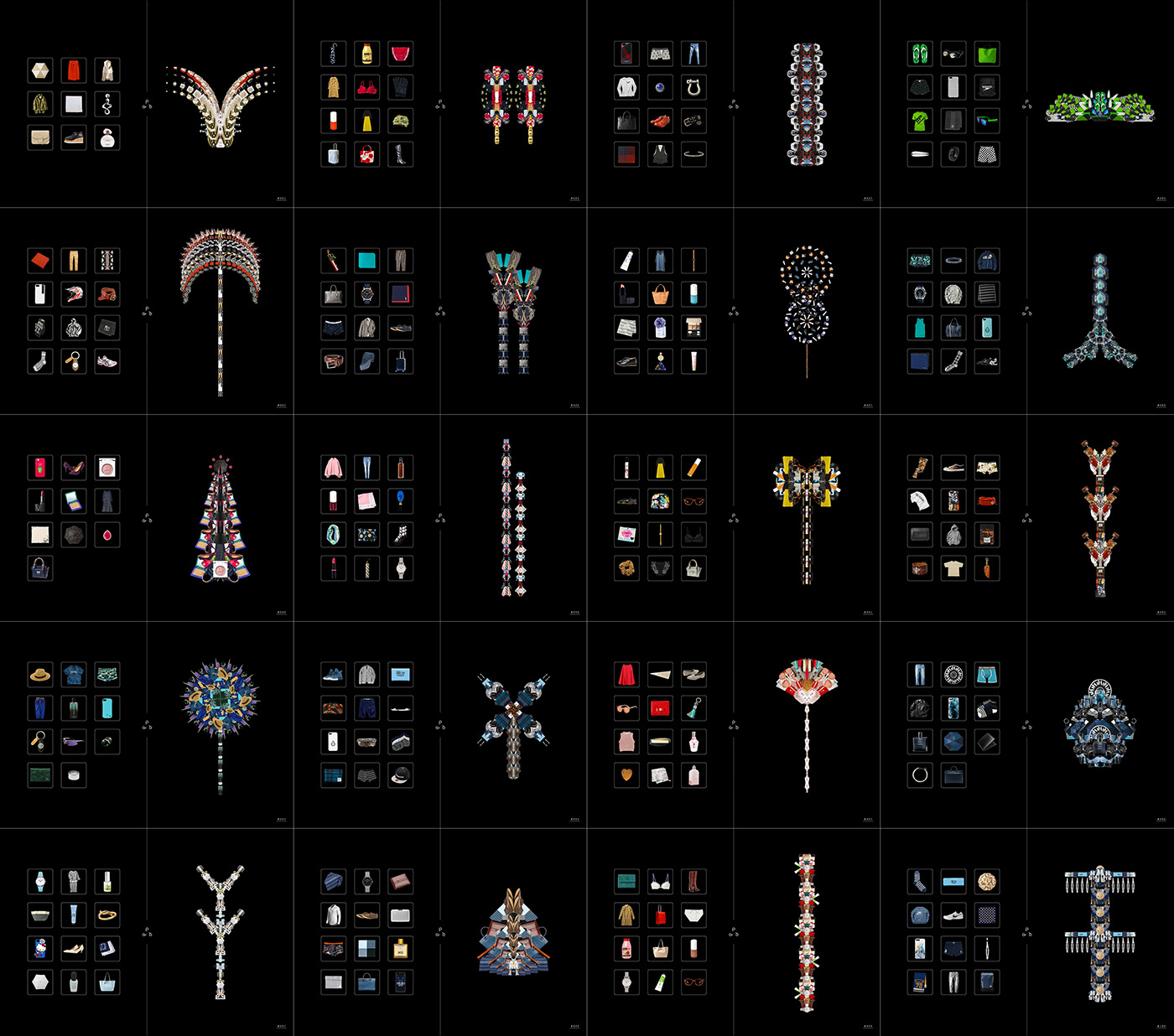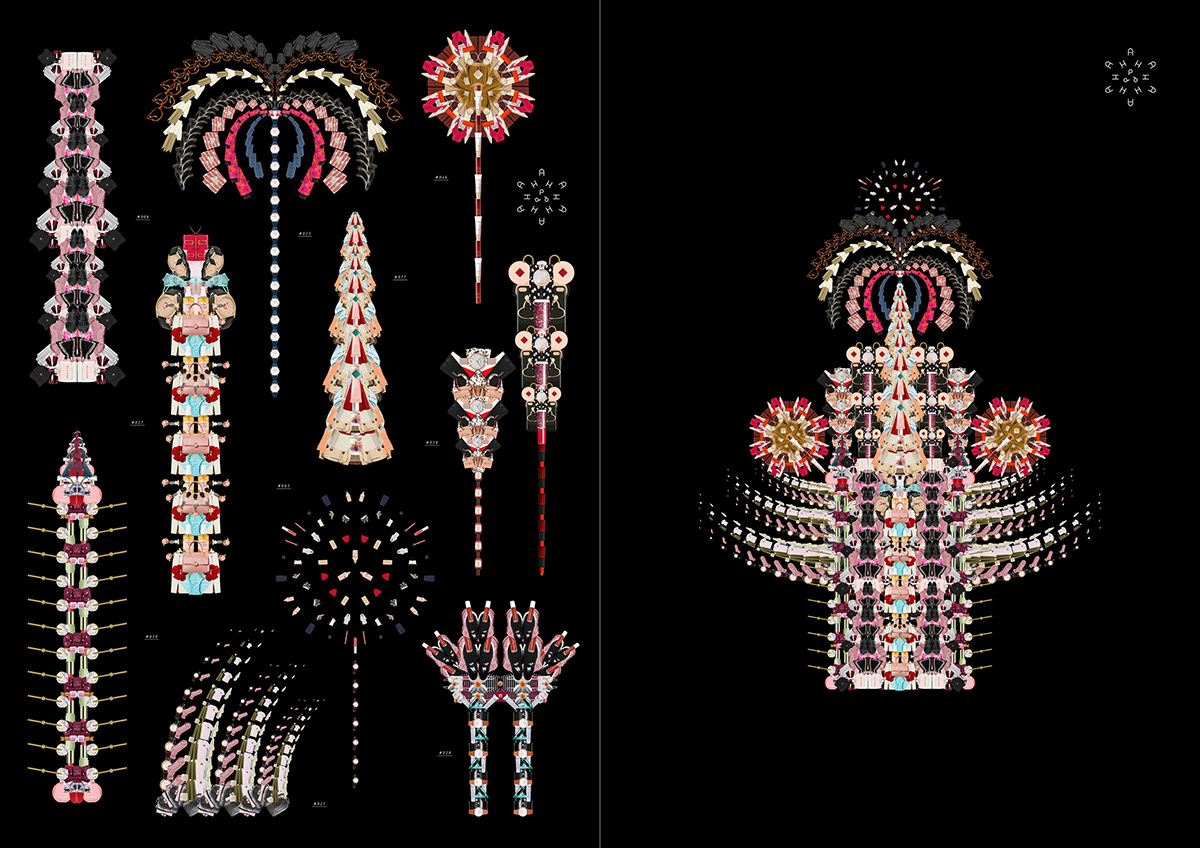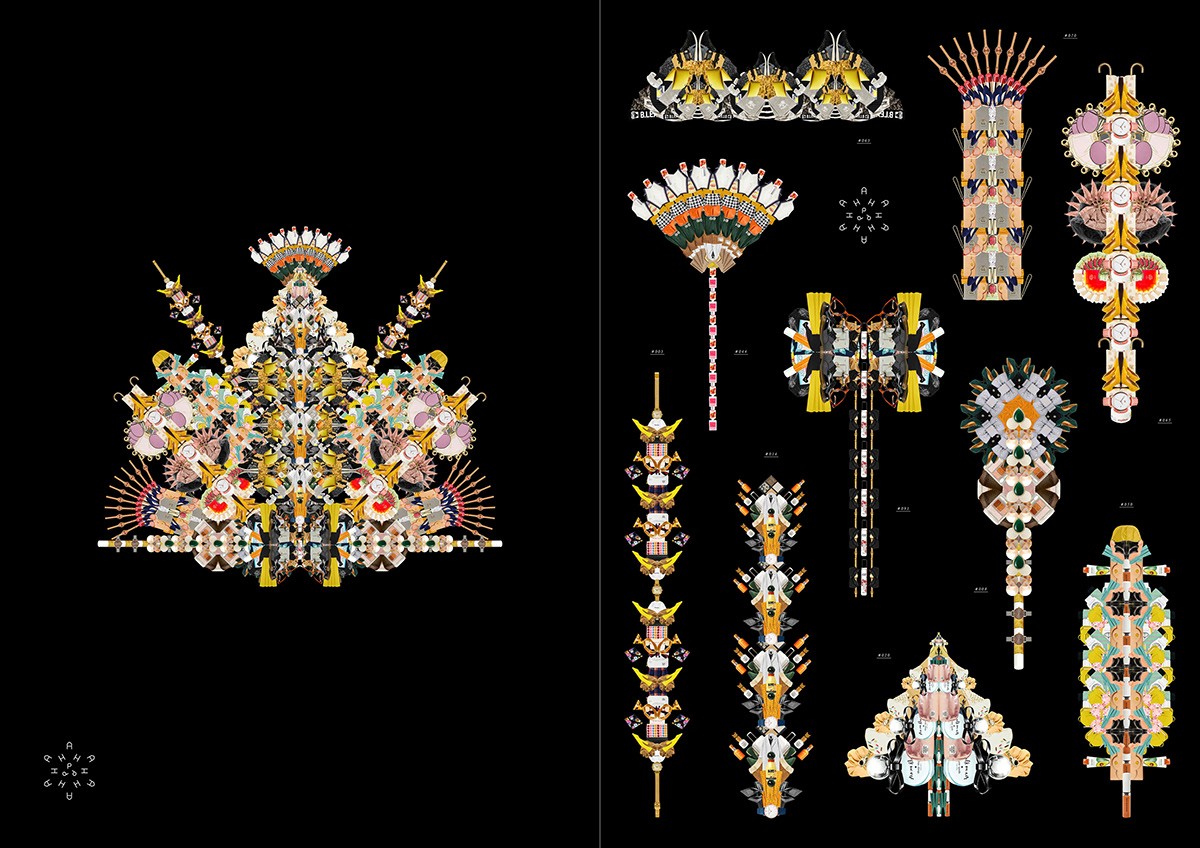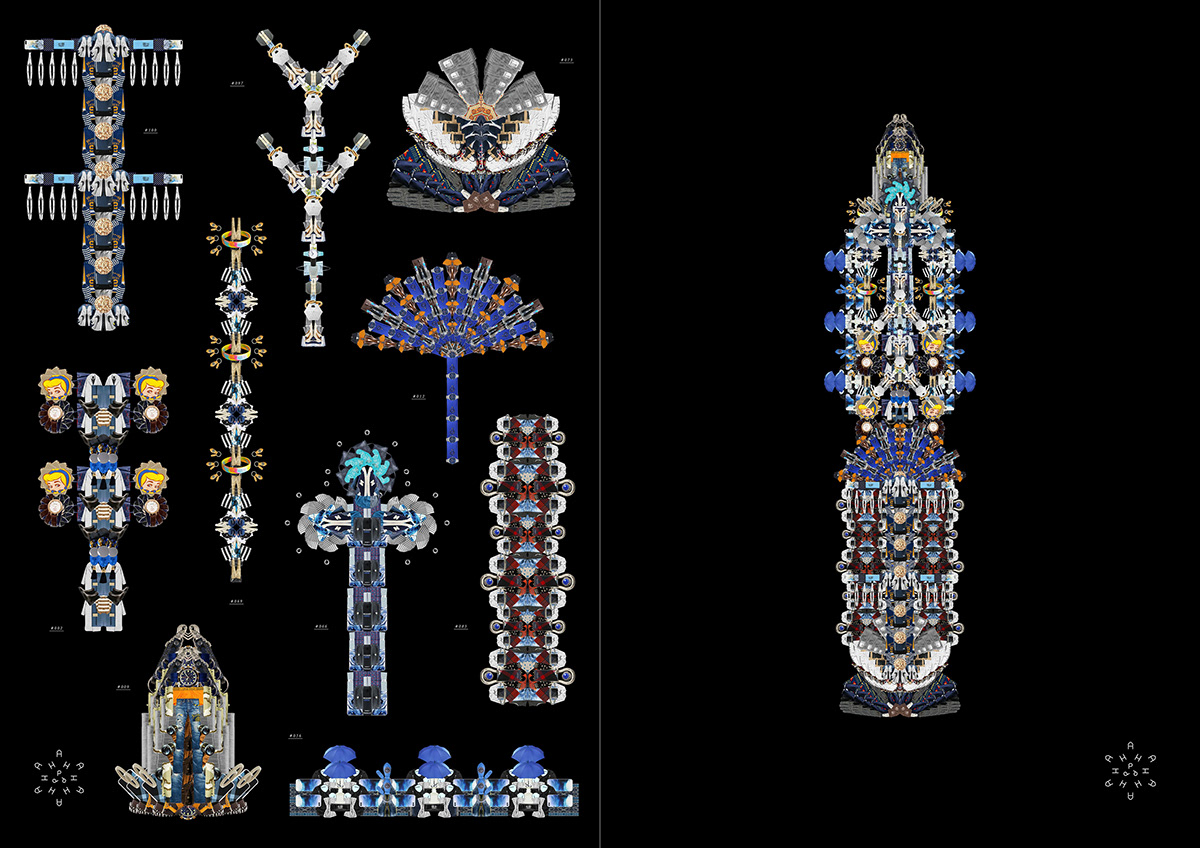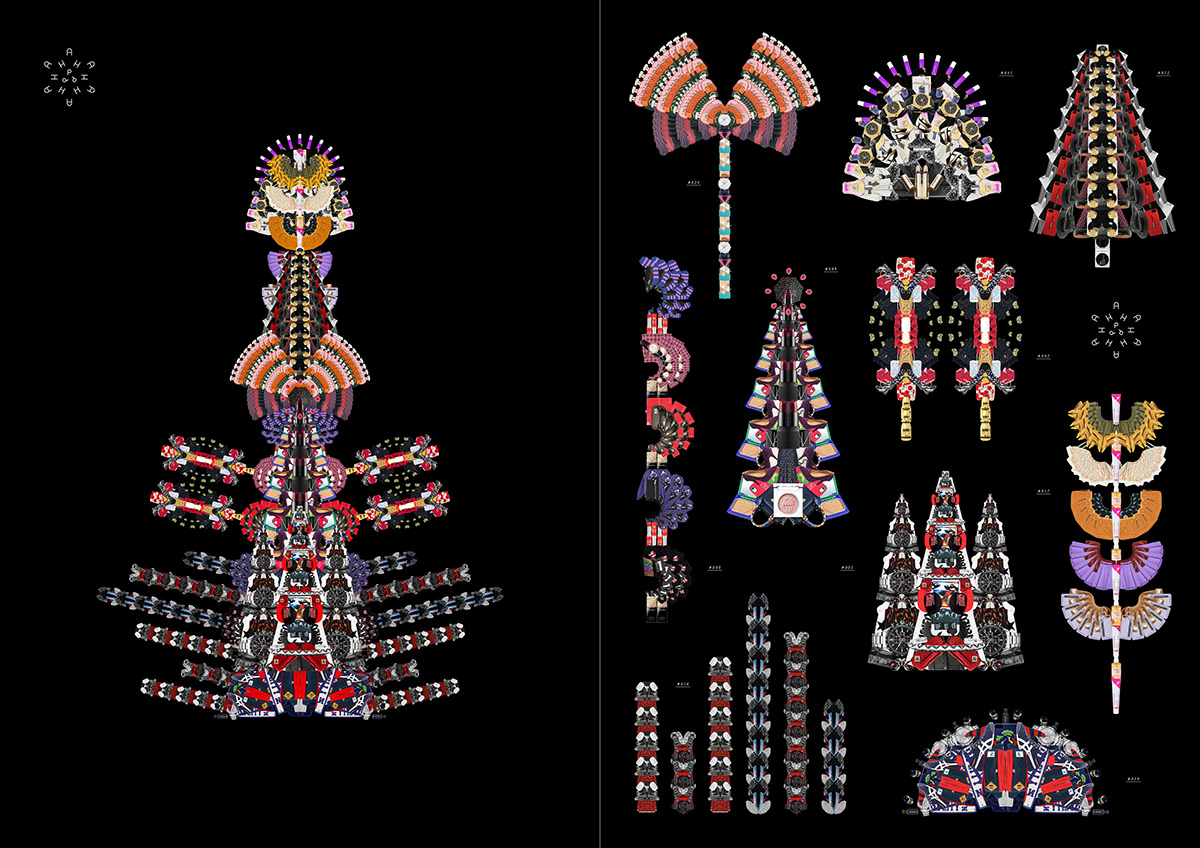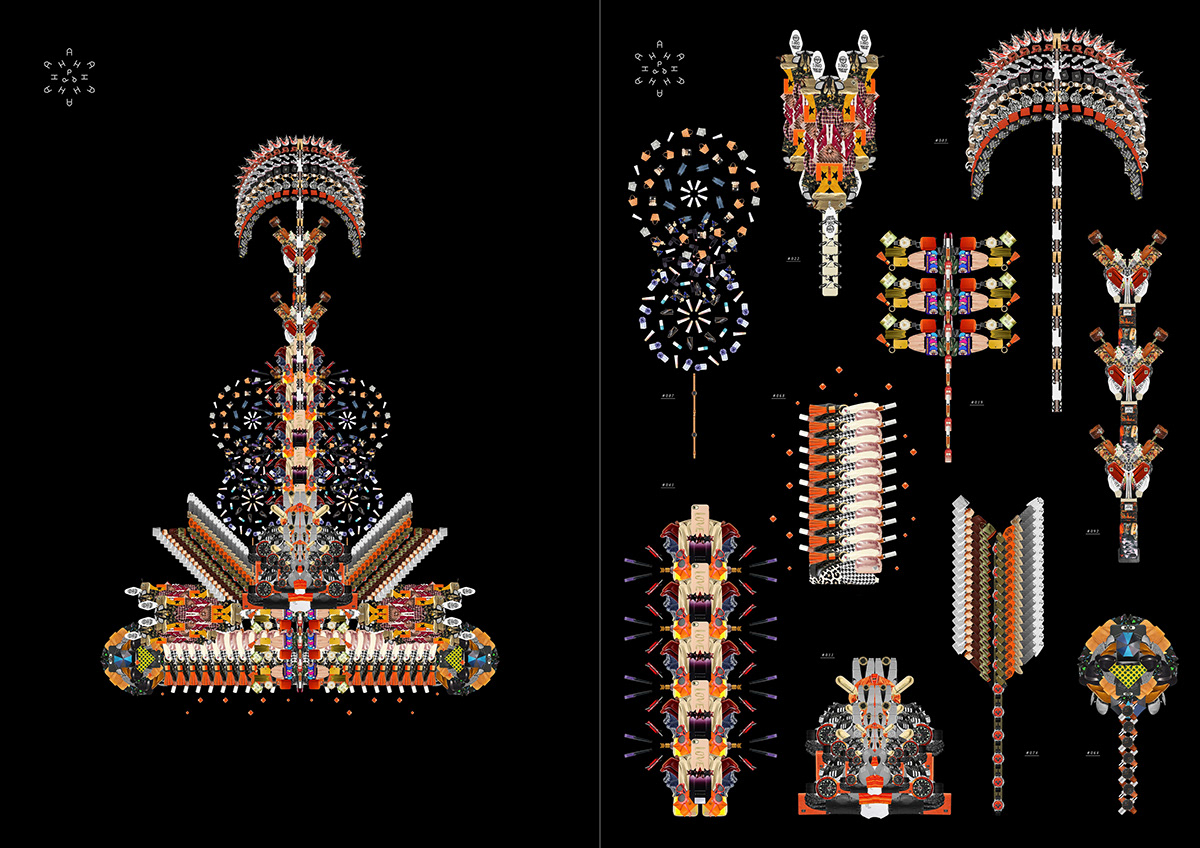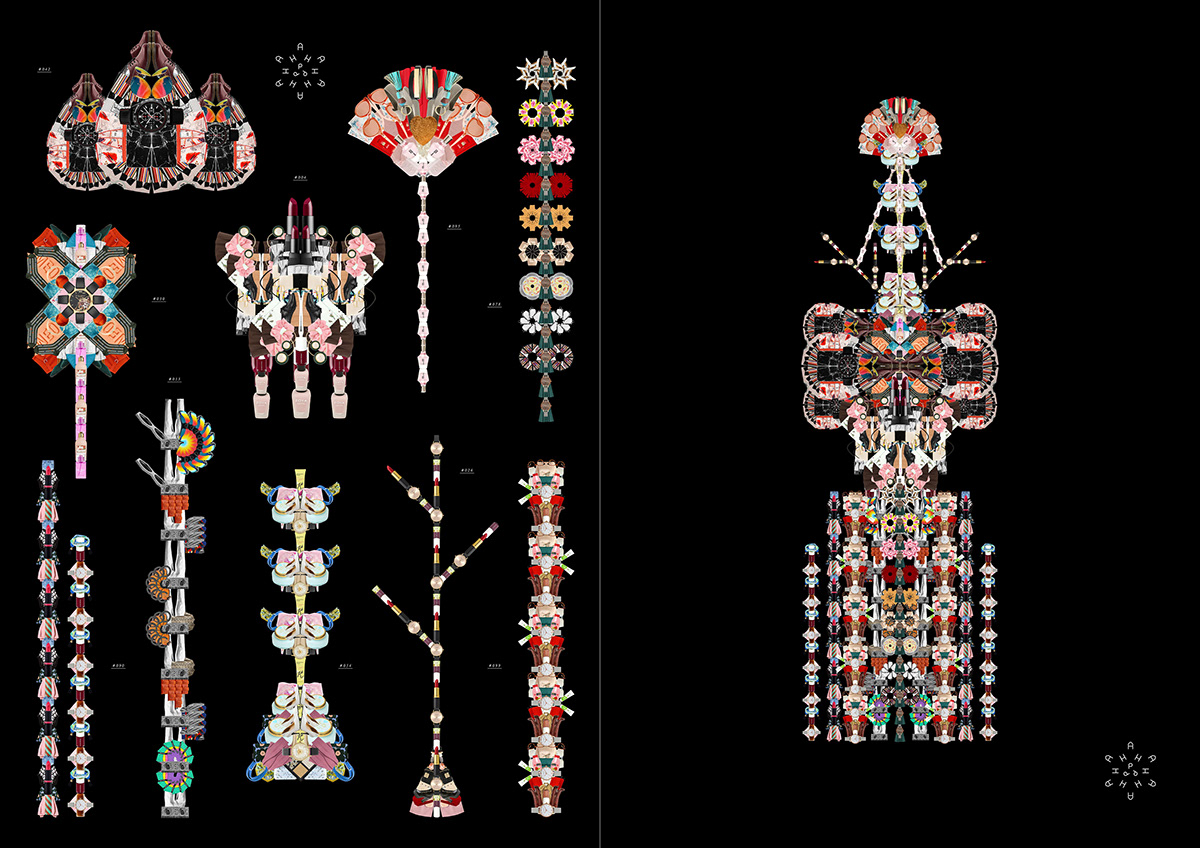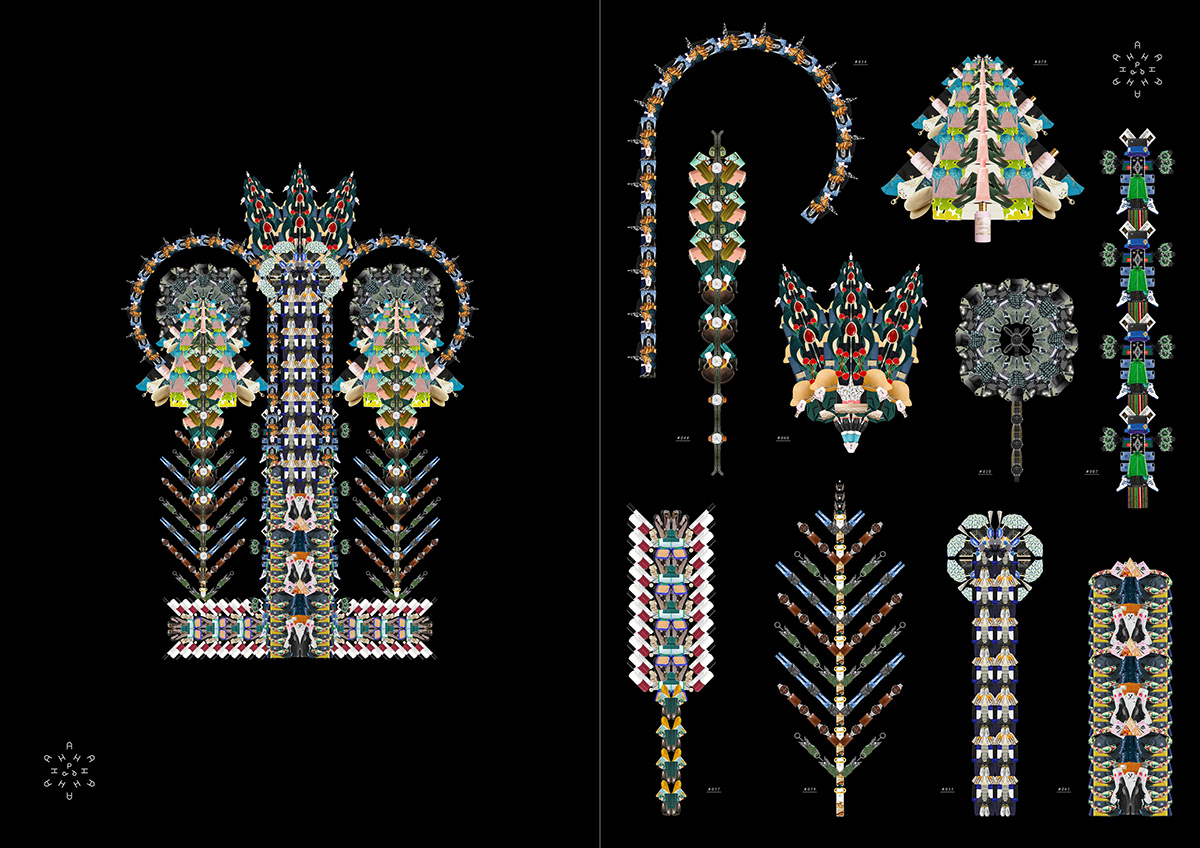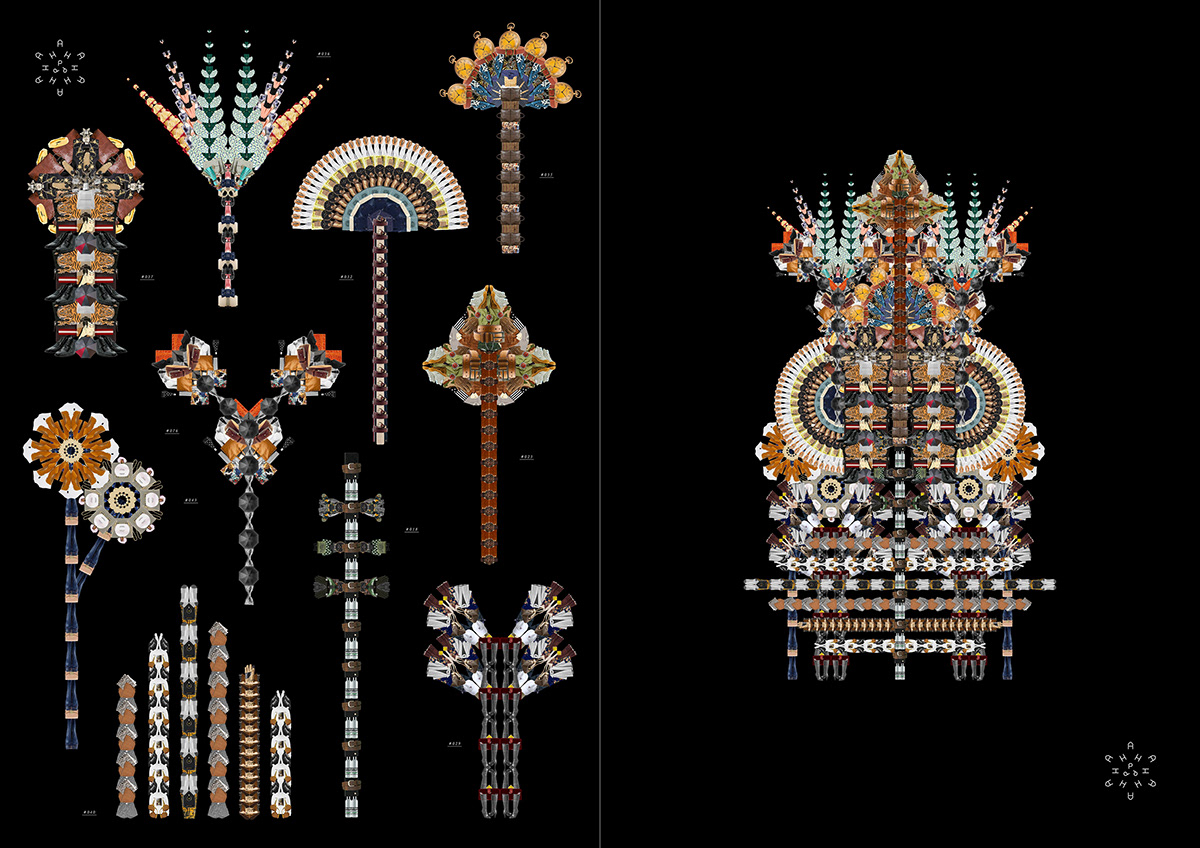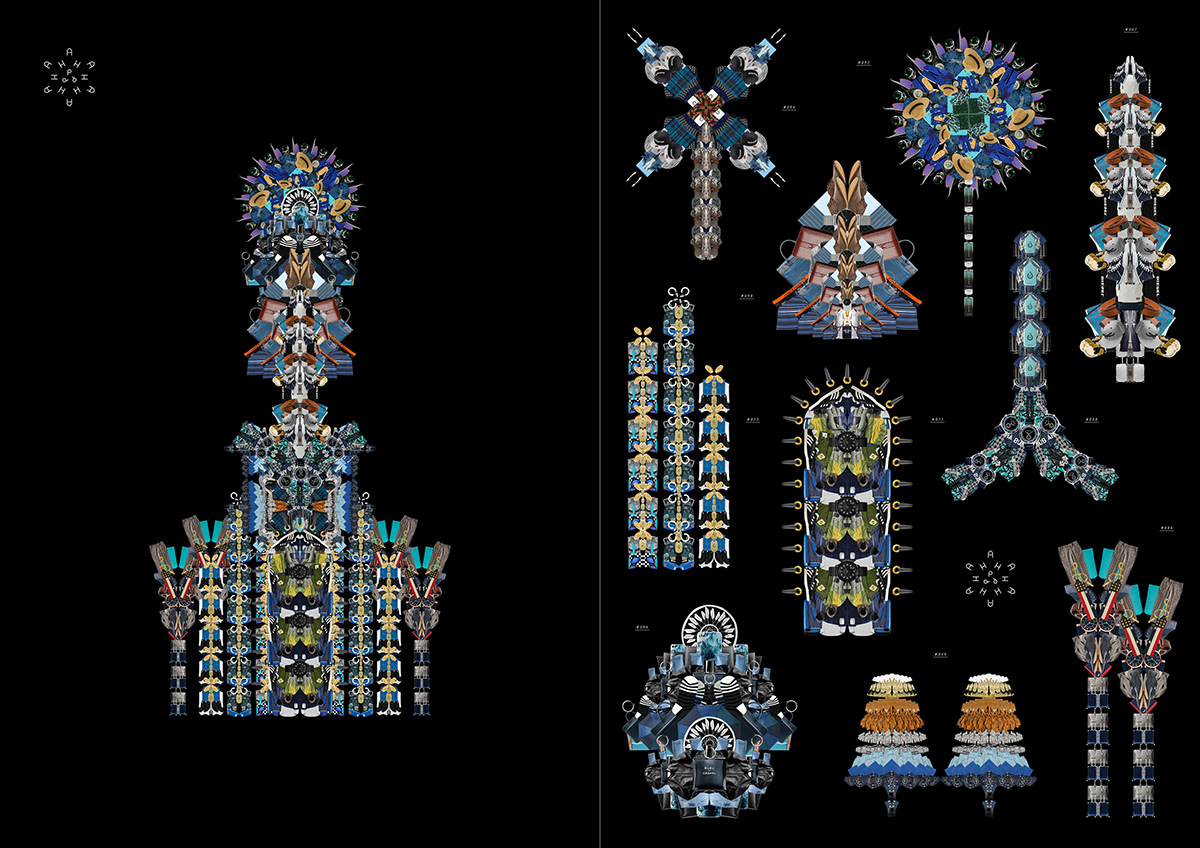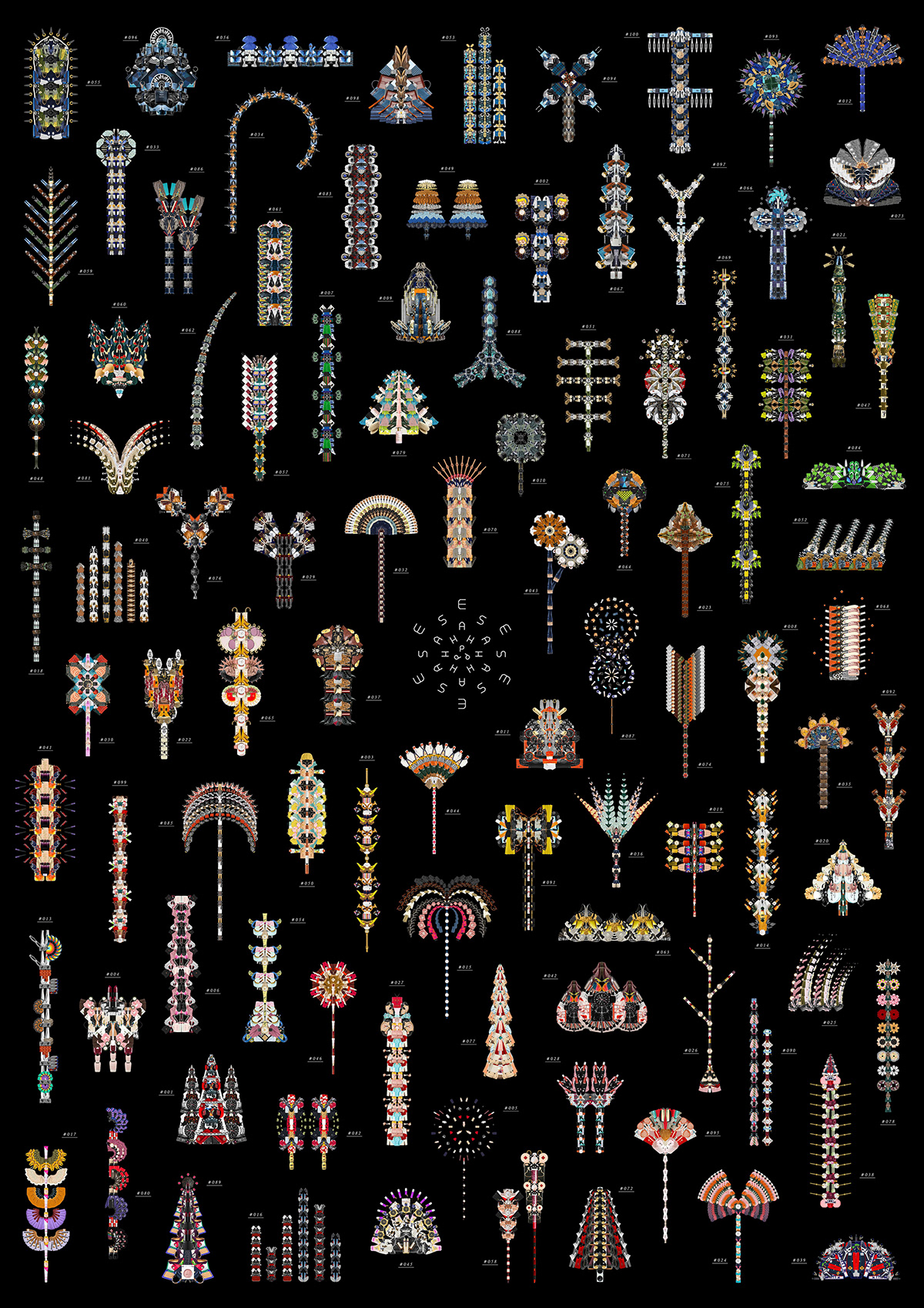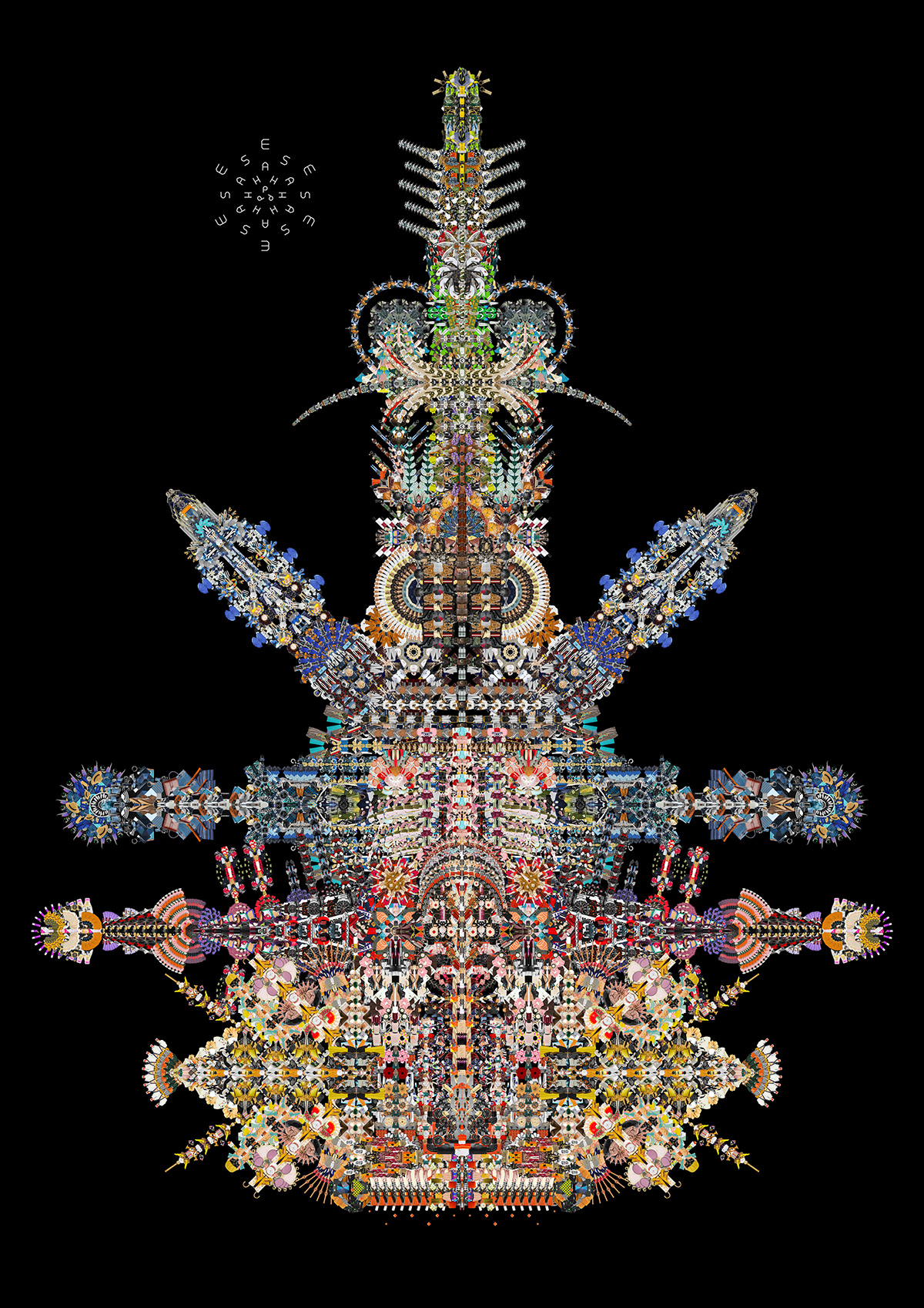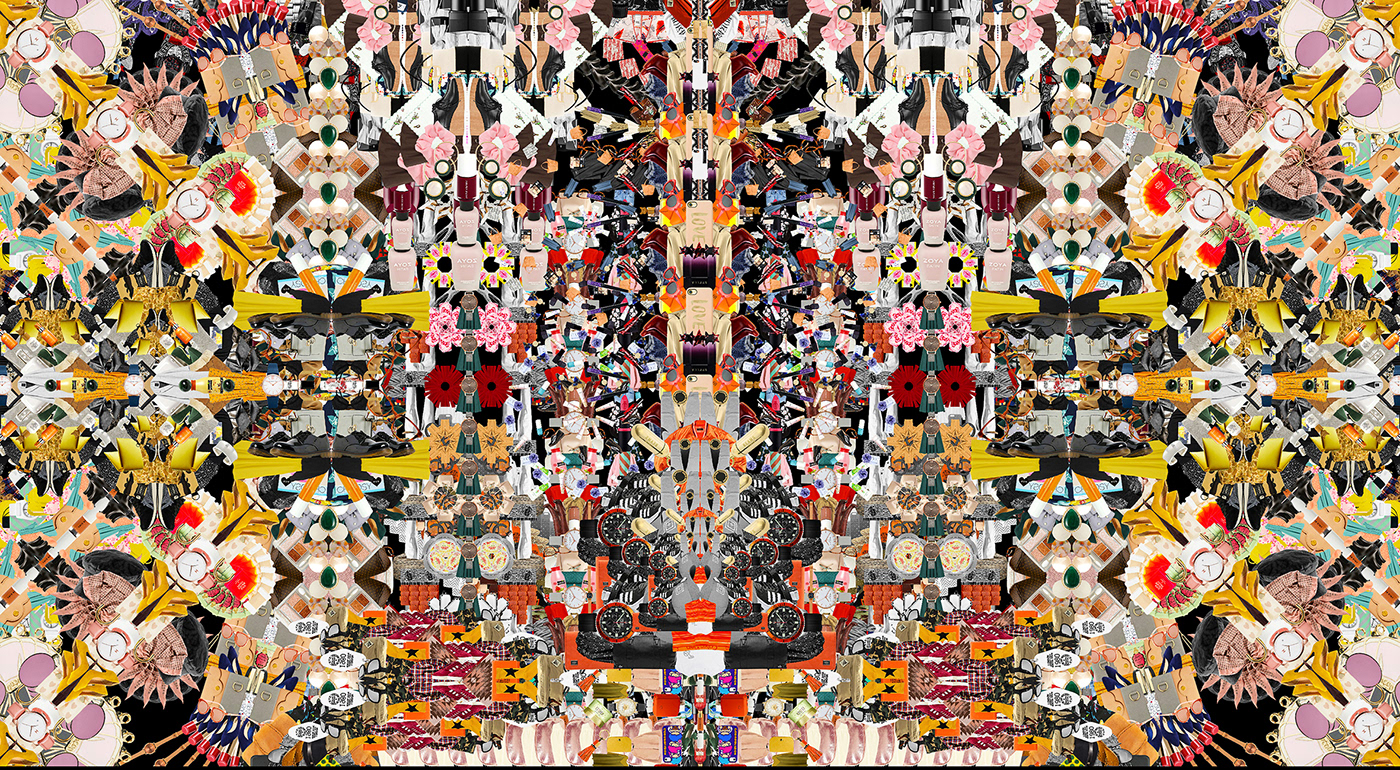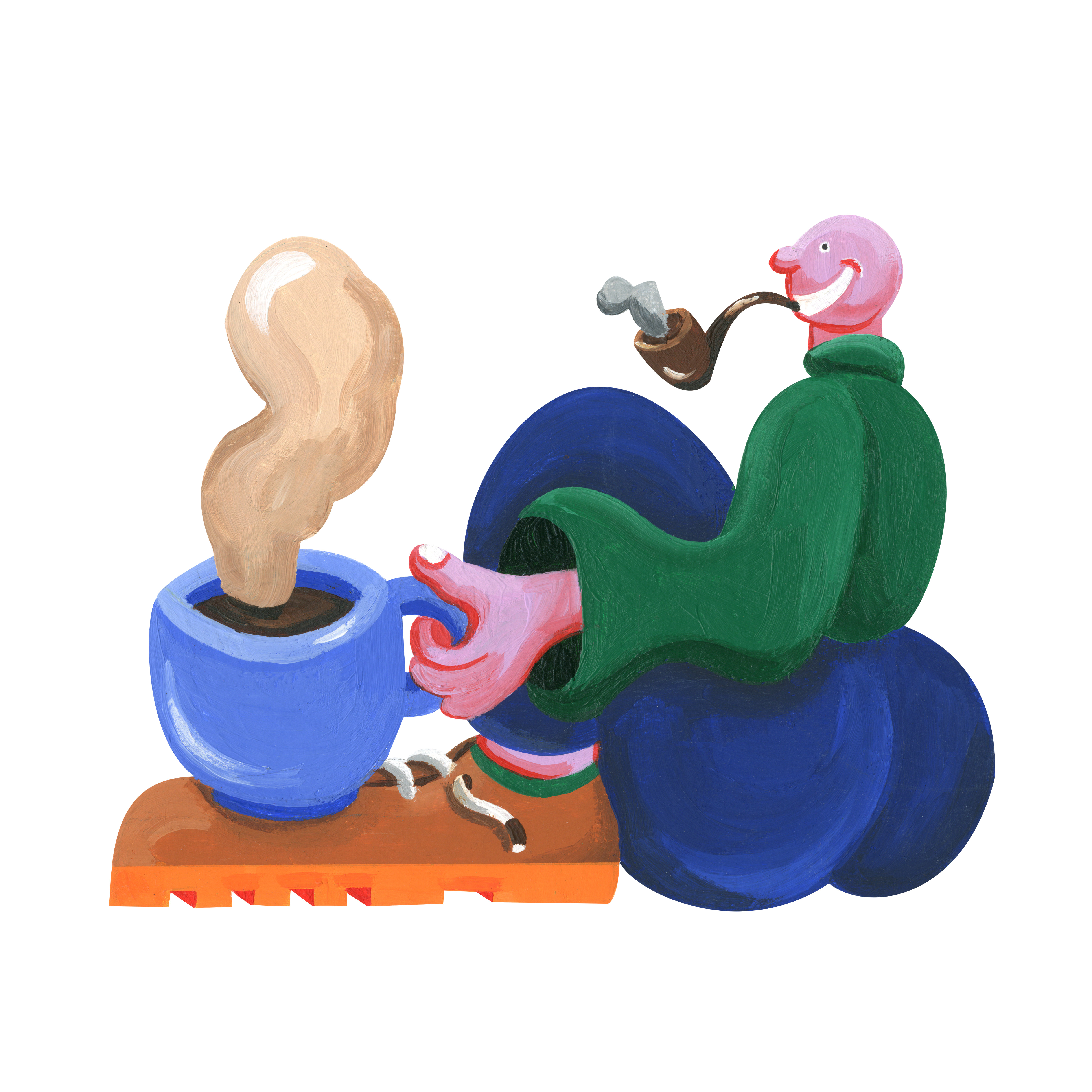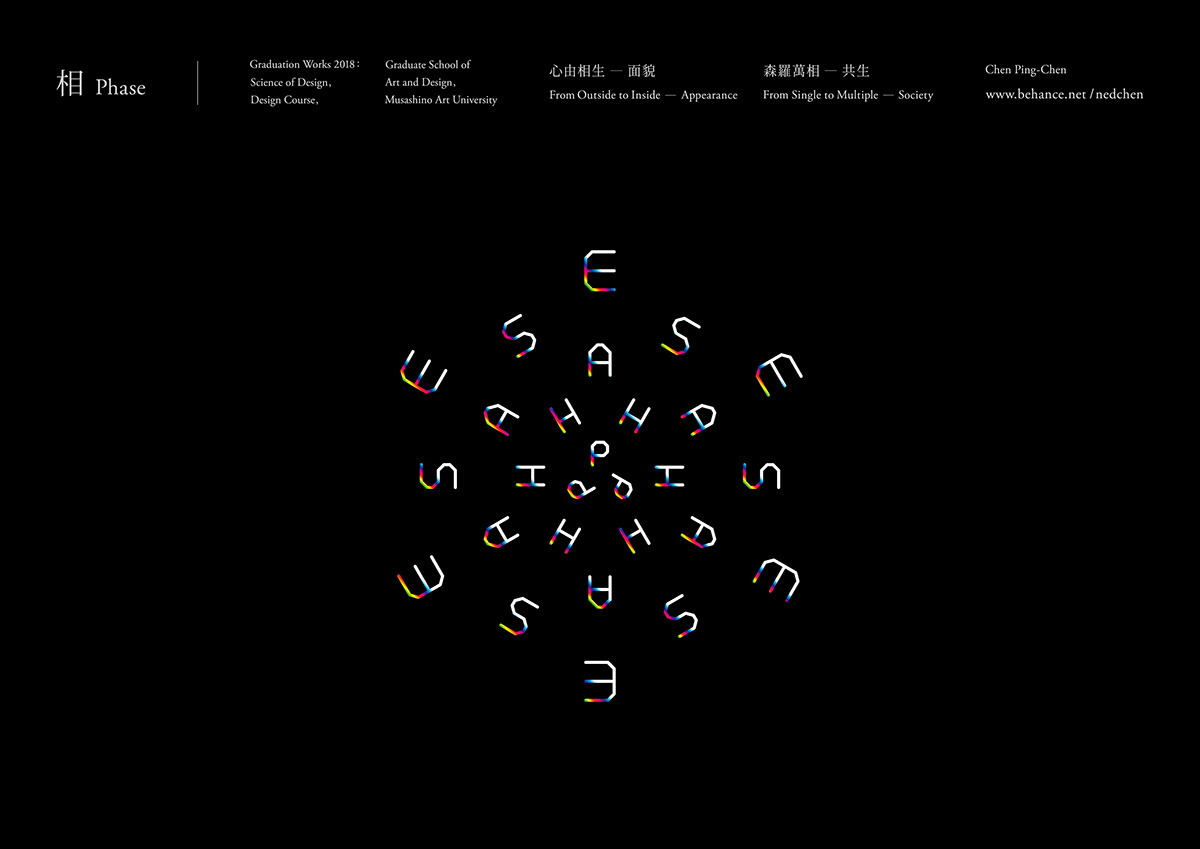
相
PHASE
PHASE
∣
Category:Graphics Artwork
Years:2018
Advisor:小林昭世 Akiyo Kobayashi, 吉田愼悟 Shingo Yoshida
Designer:陳品丞 Chen Ping-Chen
Animation:鄭念慈 Cheng Nien-Tzu
Animation BGM:郭瑜 Kuo Yu
Special Thanks:平尾始 Hajime Hirao, 邱子堯 Chiu Tzu-Yao, 游馨婷 Yu Cin-Tin, 周雅萱 Miyabi Shuu
∣
2016年,我來到日本的武藏野美術大學就讀碩士學程,接觸到了許多關於創作、關於設計更宏觀的思考,因此決定進行一項自主創作的計畫作為畢業製作,好好地來研究我自己「如何理解這個世界」。在過程中,人類多樣性所衍生的差異讓我感到特別有趣,便試著更深入地摸索「異中有同、同中有異」這句話。我們為何可以「又同又異」?何謂「獨特」?我在許多不同的方向間來回驗證這些問題,最後發現所有事物在人類「分類」的習性下,都會發展出不同層級的同異關係。我借用了一點數學「集合論」中「子集」的概念,做為思考的基礎模型:任何東西都會因標準的不同(分類的不同)產生不同的集合。每個集合內的元素可能重複、也可能毫無關係,元素集合的形態取決於判斷的標準。各個元素也會因人事時地物的不同而發生改變、反過來影響整體的集合關係。
人類(Human),是極其複雜的綜合體,在不同條件下能顯現出不同面相,並且隨時都在更新狀態。因此,人類之間並不存在任何一套「正確的」標準或分類。但在文化長期的演變之下,某些標準/分類成為了充滿意識形態、難以動搖的「先決條件」,例如:性別(Gender)。至今關於性別的分類早已不是「男」、「女」兩個類別(例如facebook所提供的性別選項已高達50個以上),但在生活中,我們仍有許多的思考被根深蒂固的二分法所制約。這令我對「性別」這樣的抽象概念感到相當神奇,便開始在其脈絡中研究一些約定俗成的符號。
我將作品主題設定為「相」。「相」意指外在的面貌、行為看起來的狀態。每個人的「相」,衣著、穿戴物應該是影響比例最高的因素,也是自我的一種投射。在我的作品中,我將每個穿戴物件視為性別符號的最小單位,這些物件便是不同集合內的元素。而物件即使相同、也會因不同組合產生不同結果。我在各大成衣銷售網站上蒐集了3729個穿戴物件,透過不同的組合方式,試著在作品裡混合性別概念中不同集合間的「異中有同、同中有異」。
「相」作品分為兩個部分,其一是「心由相生-面貌」,探討單一個體中包含多少性別外在的既定印象,以及既定印象如何反過來構成、定義個體。我藉著銷售網站上「男」、「女」的分類,取其穿戴物各組了「男」、「女」的面孔,再以各半的比例組了骷髏頭,也就是性別再往前回推一個抽象的概念:人類(Human)。而在「森羅萬相-共生」中,我著眼在群體的集合關係,以男、女各50套衣著(穿戴物件)象徵不同的人,製作了100株不同高矮、彎直、大小,像是植物的生命體。以大致的色彩進行10個分類,最終集合為一個多彩的光景。我認為,狹義的性別框架不過是分類的一種,單一個體的身份認同(Identity)應有更多幽微、曖昧的可能性。如同教師/作家Ram Dass在《Self Judgment》中值得玩味的一段話:
「當你走進森林裡,你看著樹木,看見各種不同樹木。有些彎曲、有些挺直,有些常綠、有些不知名。你看著樹,你接受它。你看懂它為何是這模樣。你大致了解它缺乏足夠陽光,所以長成那樣。你不會對它充滿情緒,只是接受它,欣賞著樹。當你一靠近人類,這些就都不見了。你不停地說:『你太這樣,或我太這樣。』審判的腦袋進駐了。所以我會練習把人變成樹。意思是,欣賞他們本來的模樣。」
∣
When I was enrolled in a master’s degree program at Musashino Art University in Japan in 2016, my mind expanded to encompass a broader scale of thinking on creation and design. Therefore, my graduation project will be an independent creation project created to explore my own means of comprehending the world. Because of my interest in the diversity of human characteristics, which establishes differences among individuals, I will explore the concept of “similarities within differences and differences within similarities.” How can we be similar and simultaneously different? What does “uniqueness” signify? I have examined these questions from numerous perspectives and discovered that people observe similarities and differences in all objects and aspects of life at various levels because of their habits for classification. I employed “subsets” from the mathematical theory of “sets” as my basic theoretical model to demonstrate that all objects form sets in relation to their unique criteria (classification). The elements within each set may overlap or completely differ from one another, and the form of a set of elements is defined according to its judgment criteria. Each element can also vary according to the person, event, location, or time, which subsequently affects an entire set.
Humans are complex beings whose individual characteristics continually vary according to circumstance. Therefore, no “correct” criteria or classifications exist among humans. However, throughout the evolution of human cultures, several criteria and classifications have become uncompromising ideology-driven prerequisites. Gender is one such example. Today, gender is no longer defined according to sex; the number of gender criteria provided on Facebook has reached over 50. Nevertheless, for many people, their thinking is adamantly limited to dichotomy. This is the reason for my interest in the abstract concept of “gender” and my examination of some of the conventional symbols within this context.
The theme of my project is “phase,” which refers to the appearance and apparent behavior of an individual. Clothing and accessories are one of the most crucial factors in the “phase” of each individual as well as being a form of self-expression. In this project, accessories were regarded as basic units of gender, which constitute elements within a set. Two identical sets of accessories may result in different outcomes according to the patterns of their combination. For this project, I collected 3,729 accessories from various websites selling clothing and combined them in various patterns to blur the concepts of male and female gender, thereby expressing the concept of “similarities within differences and differences within similarities” among various sets.
“Phase” comprises two parts. The first part, titled “From Outside to Inside—Appearance,” presents several established symbols of gender and the construction and definition of the individual by these symbols. The accessories were used to form the faces of a man and woman according to their gender classification in the aforementioned sales websites, and the skeletons of the man and woman were assembled at proportions of 50% each to present “humans” as an abstract concept before introducing gender. The second part, titled “From Single to Multiple—Society ,” focuses on the “set” relationship in a group of people. A group of 50 men and 50 women wearing unique clothing symbols (accessories) formed 100 lifeforms of varying heights, curvatures, and sizes, with diversity similar to that observed in plants. The lifeforms were divided into 10 categories according to color to create a colorful scene. To me, gender is only a type of classification, and subtlety and ambiguity are inherent in the identity of each individual. This reflects the following statements extracted from Self Judgment by Ram Dass:
“When you go out into the woods and you look at trees, you see all these different trees. And some of them are bent, and some of them are straight, and some of them are evergreens, and some of them are whatever. And you look at the tree and you allow it. You appreciate it. You see why it is the way it is. You sort of understand that it didn’t get enough light, and so it turned that way. And you don’t get all emotional about it. You just allow it. You appreciate the tree.
The minute you get near humans, you lose all that. And you are constantly saying ’You’re too this, or I’m too this.’ That judging mind comes in. And so I practice turning people into trees. Which means appreciating them just the way they are.”
∣
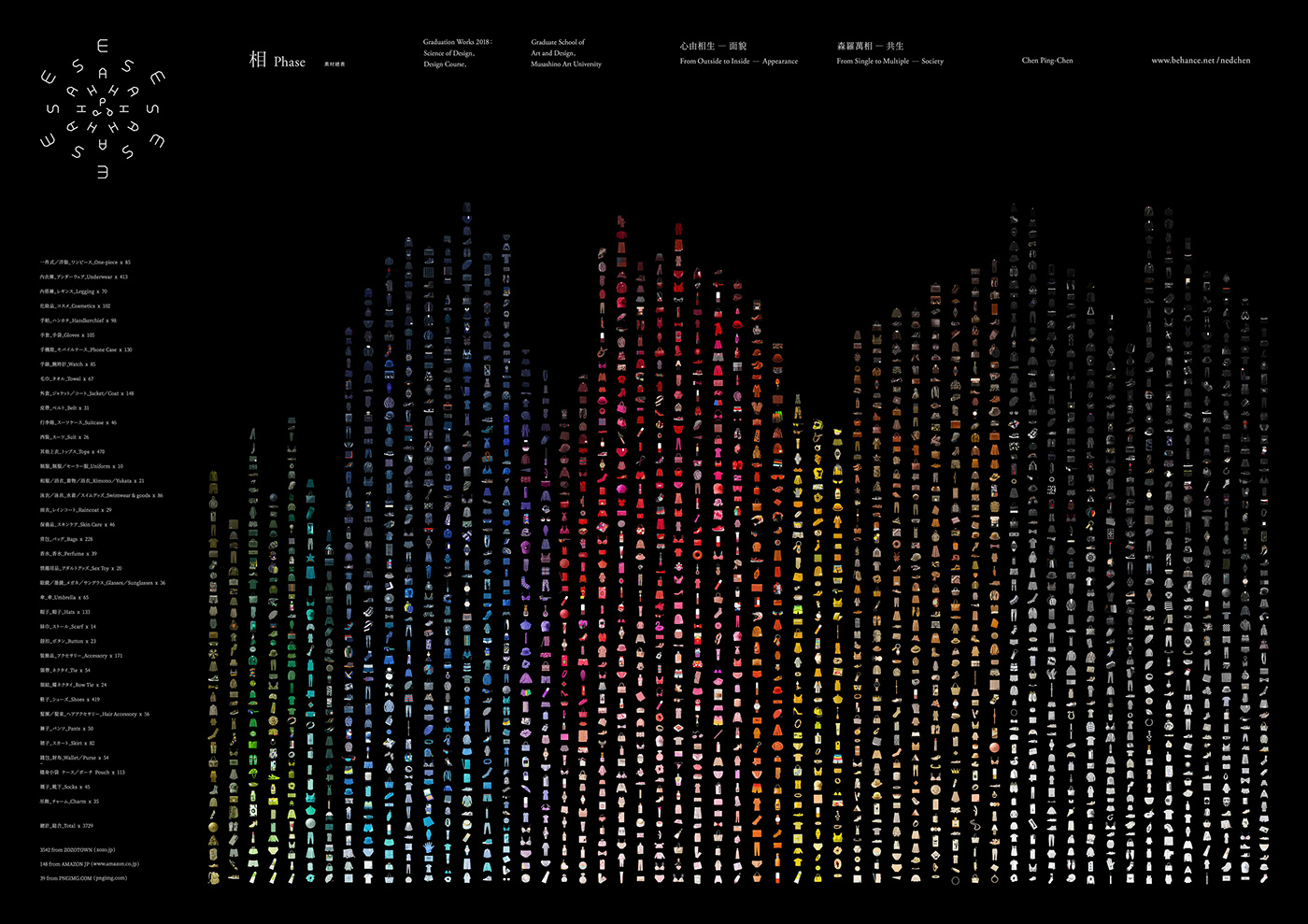
✽
《心由相生-面貌 From Outside to Inside-Appearance》
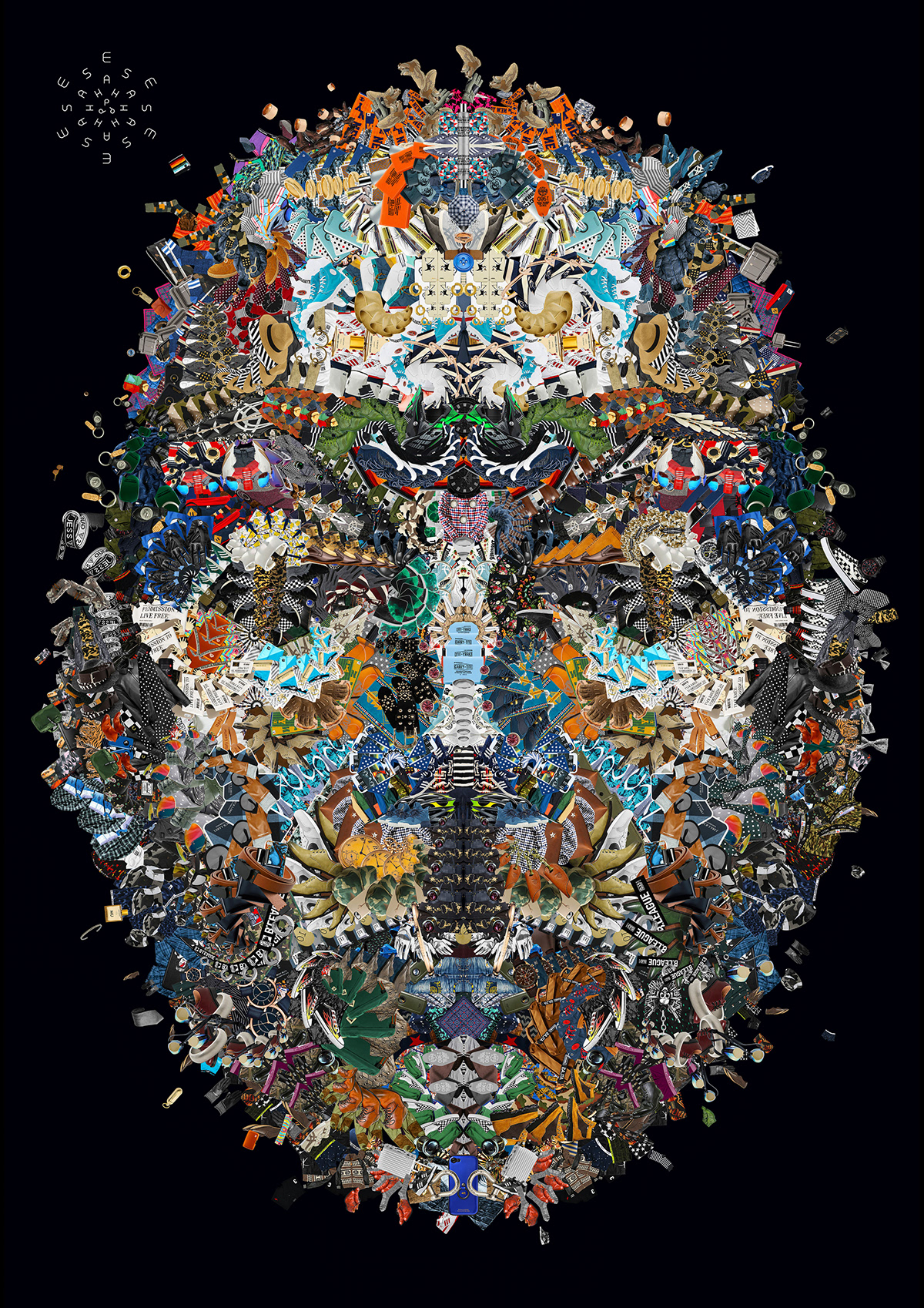
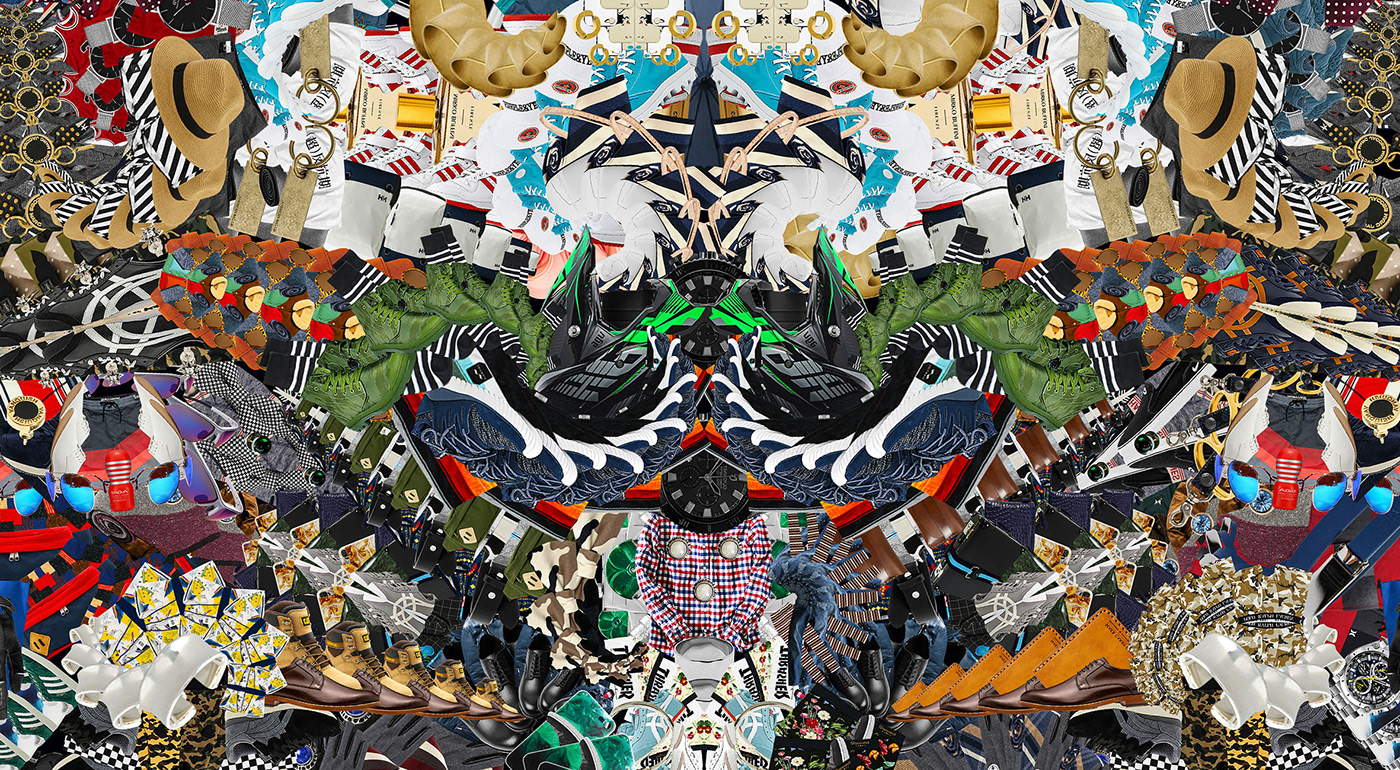
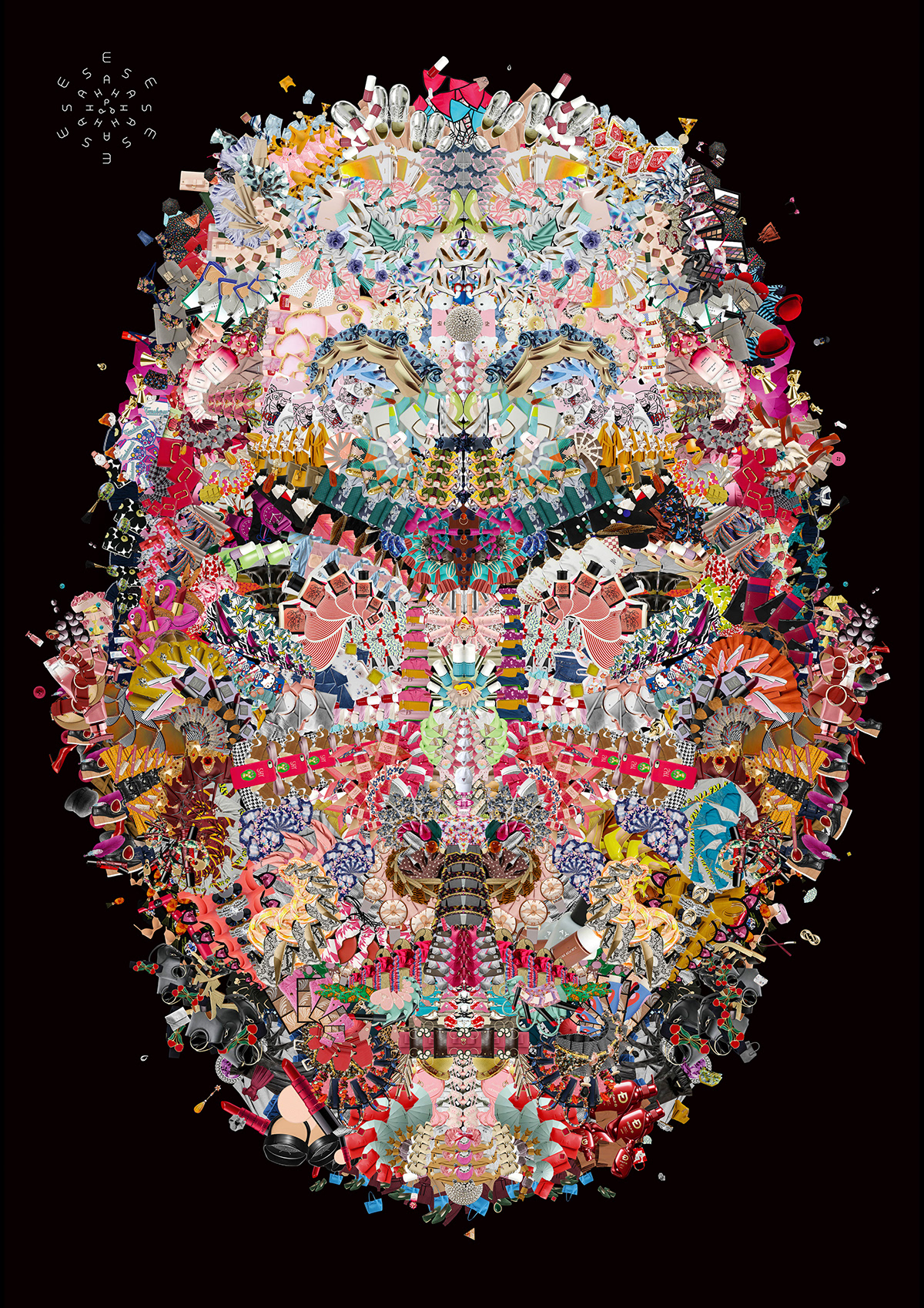
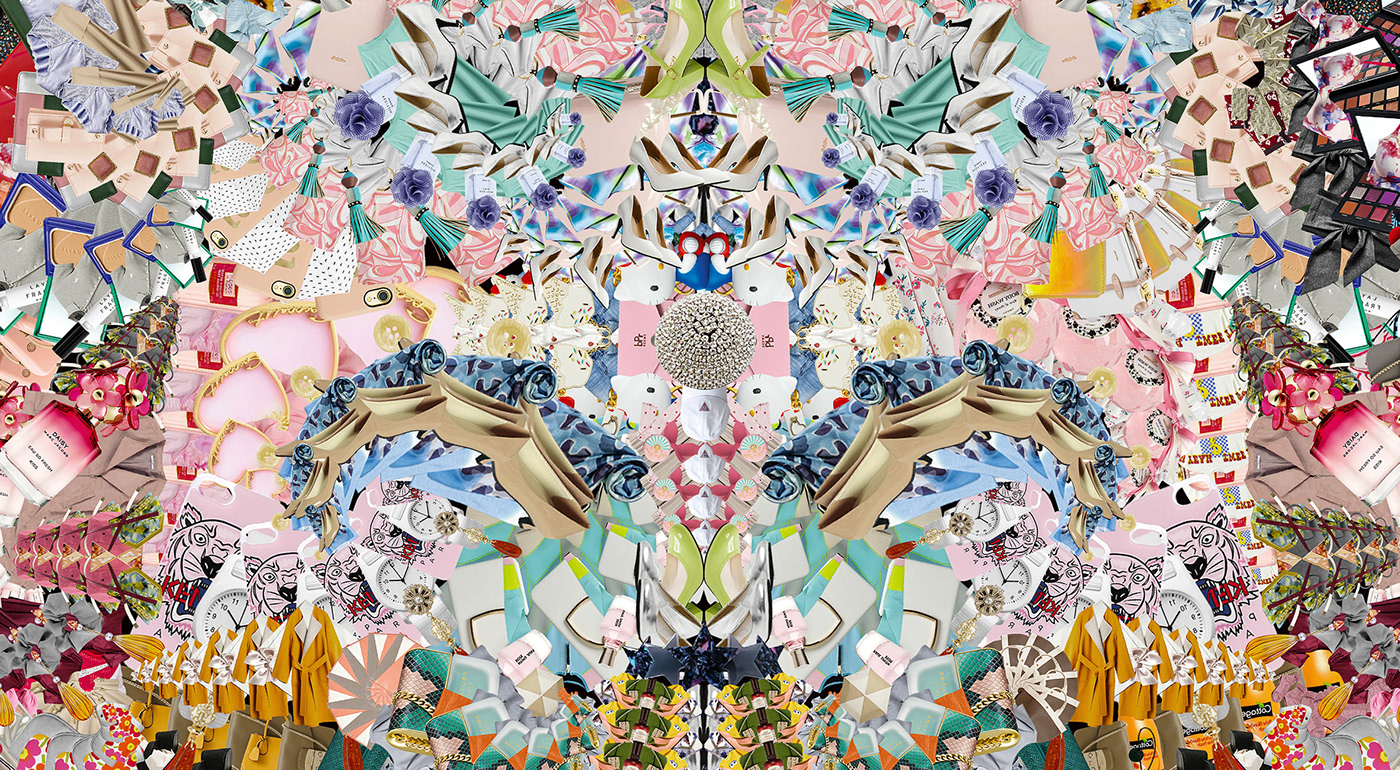
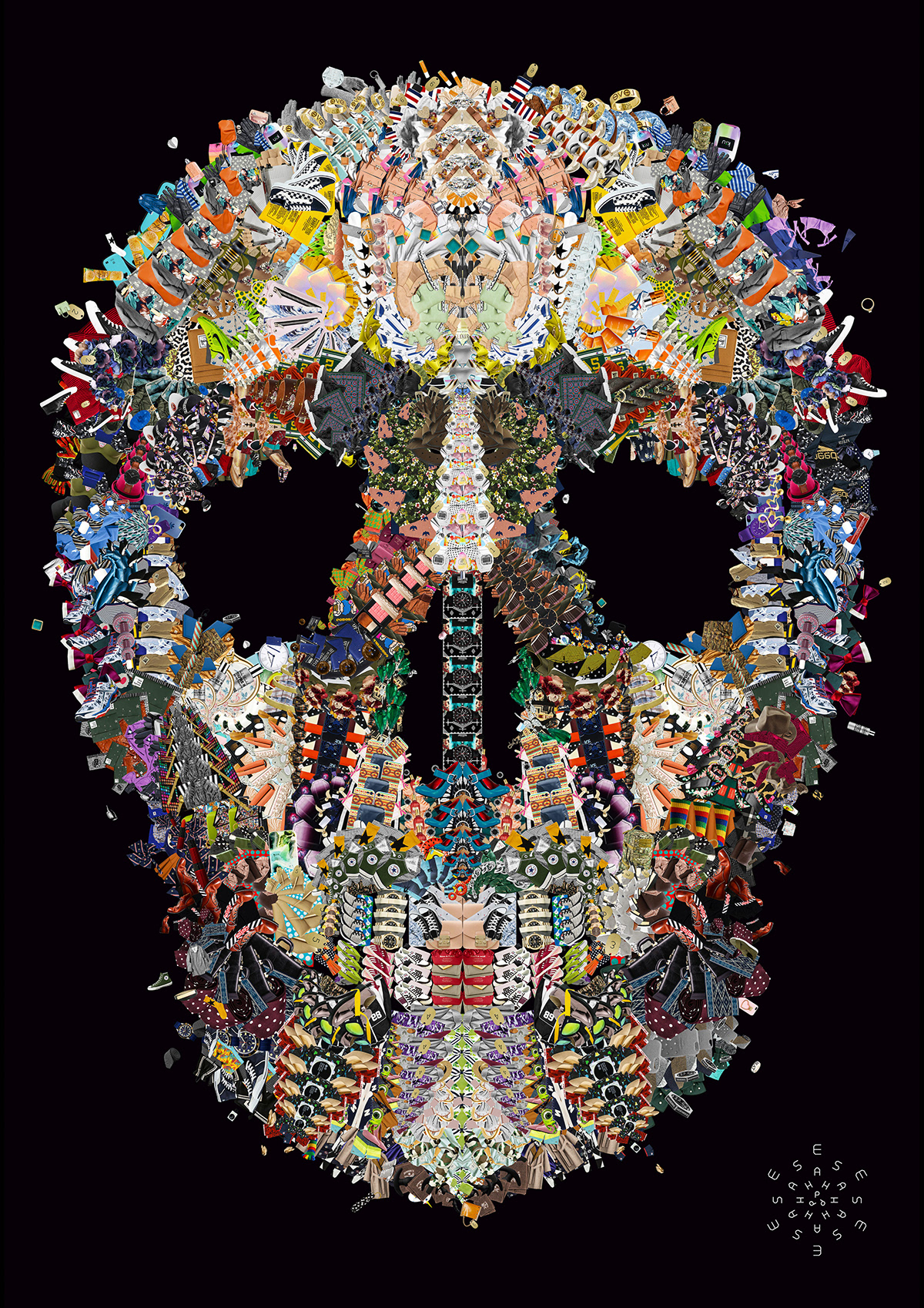

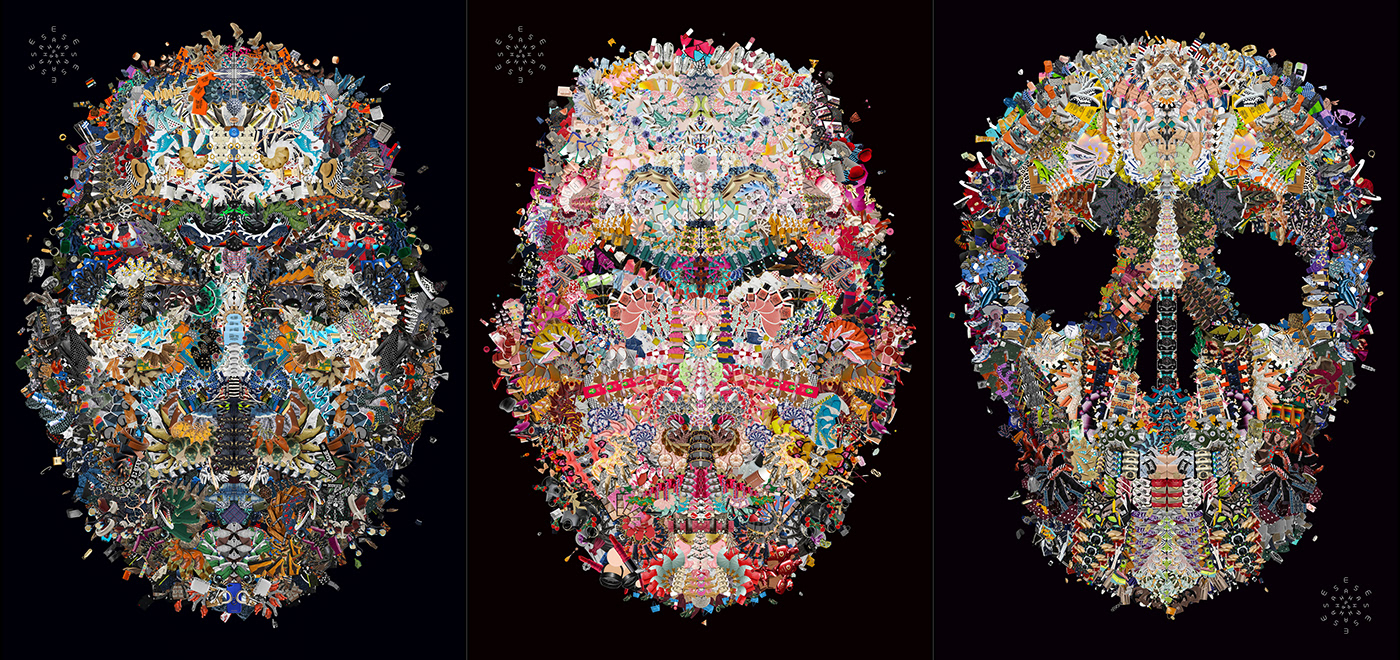
✽
《森羅萬相-共生 From Single to Multiple-Society》
